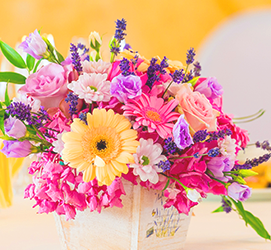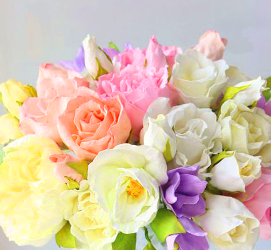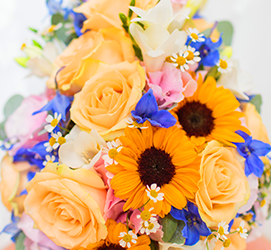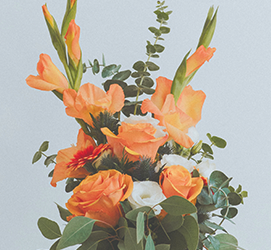Flowers: A Natural Remedy for a Happier Mood
Posted on 21/05/2025
Flowers: A Natural Remedy for a Happier Mood
Floral beauty has delighted humanity for centuries, not only gracing our environment with dazzling colors and delicate scents, but also offering profound effects on our emotional well-being. In recent years, scientific research, cultural wisdom, and personal experiences have all reinforced the idea that flowers possess mood-enhancing properties. This comprehensive guide explores how flowers can be a natural remedy for happiness, uplifting spirits, reducing stress, and nurturing a more positive outlook on life.

Understanding the Emotional Power of Flowers
Have you ever walked into a room filled with freshly cut blooms and felt your spirits instantly lift? This isn't just your imagination--there is substantial evidence showing that flowers positively impact our mood and mental health. Throughout history, people have used flowers in rituals, celebrations, and daily life to symbolize hope, love, and renewal. But what is it about blossoms that makes them a potent remedy for a happier mood?
The Science Behind Flowers and Emotional Well-being
- Color Psychology: Bright hues stimulate positive emotions. For example, yellow sunflowers can evoke joy and vitality, while blue hydrangeas generate calmness and tranquility.
- Aromatherapy: Many flowers like lavender and jasmine emit fragrances known for easing stress, anxiety, and even symptoms of depression.
- Connection to Nature: Being around nature, even experiencing it indoors with bouquets and potted flowers, reduces cortisol levels and promotes relaxation.
- Symbolic Meaning: Flowers often represent hope, love, and comfort, reinforcing positive thinking and encouragement during hard times.
How Flowers Act as Mood Enhancers
Integrating flowers for emotional well-being into your daily life is more than an aesthetic choice--it's a form of self-care. Here is how blooms can contribute to happiness and mental balance:
1. Reducing Stress and Anxiety
Studies reveal that simply viewing flowers or being in their presence can lower stress levels. The act of caring for plants and blooms offers a mindful distraction from everyday worries, encouraging relaxation. Certain flowers, such as orchids and lavender, not only delight the eye but also offer calming scents that can turn any living space into a sanctuary.
2. Uplifting Your Mood
- The presence of colorful petals, whether in a vase or a garden, stimulates the production of endorphins and serotonin--the body's natural mood boosters.
- Receiving flowers as a gift has been documented to trigger genuine, long-lasting happiness compared to other presents.
- Simply arranging or working with flowers--a popular activity in horticultural therapy--provides a natural happiness remedy.
3. Enhancing Social Connections
Flowers act as a universal language for expressing feelings. Giving and receiving them deepens bonds and fosters connection, gratitude, and affection--all vital for a positive state of mind. Gifting flowers to someone can brighten not only their day but also your own, creating a ripple effect of happiness.
The Best Flowers for Elevating Your Mood
Not all flowers are created equal when it comes to mood enhancement. Some species have been studied for their unique ability to foster a happier state of mind:
- Sunflowers: These bold, radiant blooms are linked with energy and joy, invoking cheerfulness and optimism wherever they are placed.
- Jasmine: Its sweet scent is favored in aromatherapy for reducing symptoms of anxiety and uplifting spirits.
- Lavender: Famed for stress relief, relaxation, and improved sleep, lavender is a classic choice for emotional restoration.
- Roses: Symbolizing love and comfort, roses can trigger positive emotions through both their fragrance and visual appeal.
- Gerbera Daisies: Their vibrant colors help combat low mood and brighten up any space.
- Orchids: Exotic and elegant, orchids add a sense of sophistication and calm to the environment.
The Science of Scent: How Aromatic Flowers Influence Mood
The impact of fragrance on emotional health is well-documented. Aromatic flowers, such as those used in essential oils and perfumes, contain compounds that can affect brain chemistry.
- Lavender Oil: Inhaling lavender reduces anxiety, slows the heart rate, and fosters restful sleep.
- Jasmine Oil: Proven to reduce symptoms of depression and ease stress when diffused in the home.
- Rose Petal Extract: Believed to help with relaxation and heightening mood, offering comfort during challenging times.
Integrating Flowers into Your Life for a Happier Mindset
Making flowers a part of your daily routine is a simple yet transformative way to nurture positivity and well-being. Here are some creative and effective ways to use flowers as a natural remedy for a happier mood:
Fresh Bouquets in the Home
- Place vibrant bouquets in rooms where you spend the most time--such as your kitchen, living room, and bedroom--to continually benefit from their positive influence.
- Change arrangements regularly to introduce new colors and scents into your environment, keeping the mood fresh and uplifting.
Floral Arranging as Mindfulness Practice
Arranging flowers can be a form of mindfulness meditation. Focus on the task at hand, appreciating each stem's texture, fragrance, and color. This creative process slows down racing thoughts and anchors attention in the present moment, which is known to ease anxiety and improve overall mood.
Gardening for Joy
- Planting and caring for flowers outdoors connects you with nature and offers ongoing satisfaction as you nurture life.
- Even an indoor windowsill garden or small potted plants can make a significant difference in your day-to-day outlook.
Giving Flowers to Others
Sharing the beauty and symbolism of flowers by giving them to loved ones, friends, or even strangers can foster happiness for both the giver and recipient. Random acts of floral kindness can brighten workplaces, communities, and homes.
Cultural and Historical Perspectives on Flowers and Happiness
Across the world, flowers are intertwined with practices of healing and joy. For example:
- In Japanese culture, the art of Ikebana is not only about arranging flowers but also about finding spiritual balance and mindfulness.
- In Victorian England, the "language of flowers" (floriography) allowed people to send emotional messages through bouquets.
- Many indigenous cultures use local blossoms in rituals for mental and emotional healing, conveying messages of hope and resilience.
Flowers in Modern Therapy: A Complementary Approach
Horticultural therapy and floral therapy are now well-established in wellness programs, hospitals, rehabilitation centers, and even in corporate settings.
- Horticultural Therapy: Involves gardening activities to promote physical, cognitive, and emotional well-being. Patients with stress, PTSD, or depression are particularly responsive.
- Floral Therapy: Utilizes the sensory experience of arranging and smelling flowers to encourage emotional expression and release negative feelings in a safe, creative way.
- Workplace Well-being: Offices with indoor plants and fresh flowers report higher employee satisfaction, creativity, and productivity, along with lower absenteeism.
Practical Tips: Choosing and Caring for Mood-Boosting Flowers
- Pick Diverse Colors: Select bouquets with a mix of hues--yellows for energy, blues for calm, reds for excitement, and pinks for comfort. Each color can enhance a different aspect of your mood.
- Opt for Easy-to-Care-For Varieties: Gerbera daisies, sunflowers, and chrysanthemums not only last longer but also require minimal attention, ensuring you feel uplifted every time you see them.
- Avoid Allergens: If you're sensitive to pollen, seek hypoallergenic flowers such as orchids and roses to minimize negative physical reactions.
- Choose Locally Sourced Blooms: Local flowers are often fresher and carry less environmental footprint, which can contribute to a sense of well-being and responsibility.
- Mix Scents Sparingly: Combine aromatic blooms judiciously to avoid overwhelming your senses. A single fragrant variety, like lavender or jasmine, can suffice for a whole bouquet.

FAQ: Flowers and a Happier Mood
- Can artificial flowers have the same effect as real ones? While artificial flowers can brighten a space visually, the emotional boost is greatest with fresh flowers due to their scent and tactile sensations.
- How long does the mood-enhancing effect of flowers last? Research suggests feelings of happiness from receiving flowers can last for days, while ongoing exposure to fresh beds or bouquets offers continuous benefits.
- Which flowers are best for mental health? Lavender, jasmine, sunflowers, roses, and gerbera daisies are among the top choices due to their color, scent, and proven psychological effects.
- Can flowers help with depression? They are not a substitute for professional treatment but can complement it by brightening the environment, reducing stress, and providing sensory comfort.
Conclusion: Let Flowers Bloom in Your Life
Whether you choose to gift a vibrant bouquet, grow a windowsill garden, or simply pause to appreciate nature's colors and scents, incorporating flowers as a natural happiness remedy is a timeless and effective way to boost your mood. Flowers remind us to slow down, cherish beauty, and connect both with ourselves and those around us. As science and tradition have shown, their subtle magic can be a gentle, accessible remedy for a happier, brighter mood--every single day.
```






